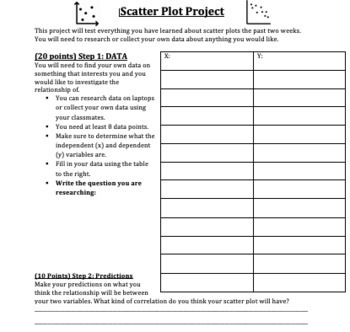Scatter Plot Project
- Zip
Description
This is an awesome research project that is summative assessment for a Scatter Plot unit.
For this project students are asked to pick a research question about bivariate data, gather the data online or through a survey. Next, they will make a prediction, construct a scatter plot, draw a line of best fit, find the equation of a line of best fit, and answer analytical questions about the data by interpreting the scatter plot.
This is a great project that will allow students to utilize technology to research a topic of interest. This will also test their understanding on all parts of scatter plots, including all 8th grade content standards under probability.
My students loved this project and were engaged during class time. It was interesting for them and allowed them to be creative on what they enjoyed.
This product contains 3 different documents. This includes:
1. Bivariate Data Examples: A range of different interesting topics/questions for students to use for this research project. (1 page)
2. Scatter Plot Project: The project itself which is described above. (4 pages)
3. Rubric for the project. (1 page)
The product is a zip file of 6 documents. Each of the 3 worksheets described above is given as a PDF AND as a word document so you can print right away or edit it as you please (since the point values are indicated on the project and you may want to change them!)
I hope you enjoy this project!! Let me know what you think.



